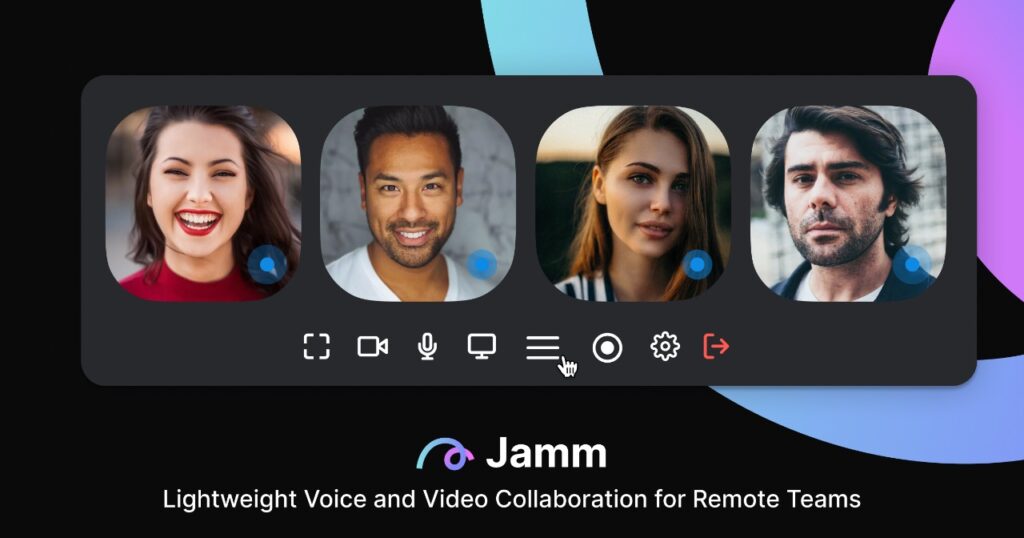This inspiring story is of a rising startup called Jamm, started by Badri Rajasekar. Quick team huddles, ad-hoc brainstorms, and water cooler sessions for remote workers often get lost in the shuffle with formal meeting links and calendar invites. Remote teams are looking to enable more casual conversations with teammates, removing barriers for sharing new ideas when they come to mind. We all need the in-between-meeting conversations over lunch or across desks that more closely mimic how we communicate and collaborate in person, and that’s why we created Jamm. Here is the story of Jamm in Badri’s own words.
Introduce us to the idea of Jamm
Jamm is a lightweight video collaboration app for remote teams that are designed to eliminate communication barriers, offering spontaneous connections and short “burst-y” conversations for remote teams. It features 1-click video conferencing with shareable, customizable URLs, and a “floating head” talking experience so you can continue with what you are working on while you chat with teammates.
It includes a full suite of collaboration features including presence detection with timezones, instant chat messaging, screen-sharing, and whiteboarding to make it easy for teams to catch up on project updates, brainstorm, and share new ideas.

What’s your strategy story? What led you to start Jamm?
The world is becoming truly democratized and your geography should not determine the opportunities you have. Previously as CTO of TokBox, a video API platform, I was fortunate enough to be able to collaborate with incredibly talented people all over the world. Enabling organizations and teams to collaborate effectively by enabling the next generation of video-first applications will let us play a part in enabling this future.
What marketing, operation strategies are you adopting at Jamm?
We built something that addressed an authentic need for teams and most of our go-to-market was profoundly facilitated by the black swan event of 2020: the pandemic. While we envisioned creating a niche for developers, we ended up becoming ubiquitously adopted by all types of teams.
The increase of remote work has driven demand for an alternative way for teams to communicate. Today, we now see teams wanting videos to be part of the very applications they work with so they can work side-by-side with colleagues using those same applications.
Any strategy mistakes you have made and what did you learn?
Of course, with the normal ebb and flow of a startup, we quickly learned to keep running while we innovated. So something I like telling new founders is that while it’s important to “keep breaking things” and building more, we need to make sure there’s adequate support offered to those who jumped in on an earlier version of the product. Many startups tend to focus on the future without ensuring everyone is on board for the journey.
Finally what advice do you have for your fellow entrepreneur readers?
I have two pieces of advice. First, and most importantly, listen to your customers. We would not be where we are today without their valuable feedback. We have them to thank for driving new features and continuing to improve our product.
Secondly, we are strong believers in short sprints, reviewing metrics, and listening to customer feedback to help us make fast, continuous iterations to improve Jamm. Doing this means removing communication barriers. Our team is spread across five different countries and we use Jamm every day to share ideas, brainstorm, and review code and metrics in order to help us continuously improve the video collaboration experience for our customers.
Disclaimer: The information in the above story is provided by the startup and The Strategy Story takes no responsibility for the authenticity of the product and services offered by the startup. Reader’s discretion is advised.
Check out stories of other aspiring Entrepreneurs
Also, check out our most loved stories below

Johnnie Walker – The legend that keeps walking!
Johnnie Walker is a 200 years old brand but it is still going strong with its marketing strategies and bold attitude to challenge the conventional norms.

Starbucks prices products on value not cost. Why?
In value-based pricing, products are price based on the perceived value instead of cost. Starbucks has mastered the art of value-based pricing. How?

Nike doesn’t sell shoes. It sells an idea!!
Nike has built one of the most powerful brands in the world through its benefit based marketing strategy. What is this strategy and how Nike has used it?

Domino’s is not a pizza delivery company. What is it then?
How one step towards digital transformation completely changed the brand perception of Domino’s from a pizza delivery company to a technology company?

BlackRock, the story of the world’s largest shadow bank
BlackRock has $7.9 trillion worth of Asset Under Management which is equal to 91 sovereign wealth funds managed. What made it unknown but a massive banker?

Why does Tesla’s Zero Dollar Budget Marketing Strategy work?
Touted as the most valuable car company in the world, Tesla firmly sticks to its zero dollar marketing. Then what is Tesla’s marketing strategy?

The Nokia Saga – Rise, Fall and Return
Nokia is a perfect case study of a business that once invincible but failed to maintain leadership as it did not innovate as fast as its competitors did!






